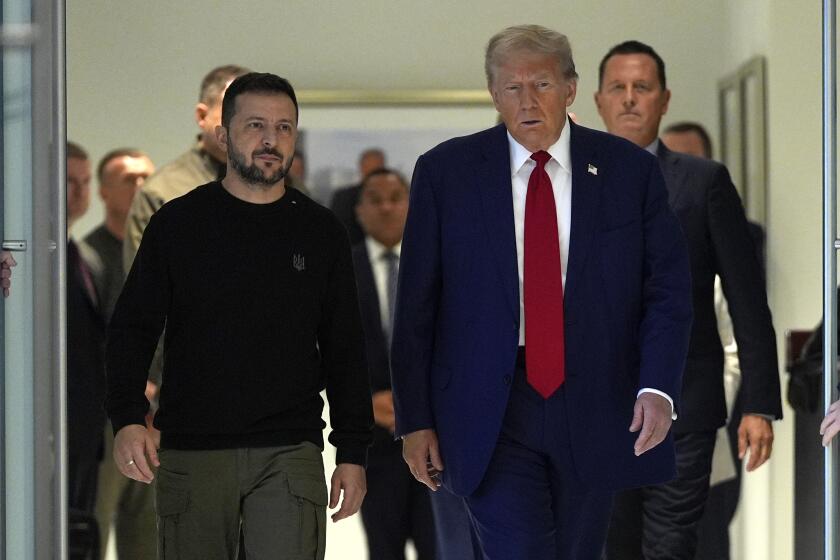Mexico general battles Tijuana drug traffickers
Reporting from Tijuana — Gen. Alfonso Duarte Mugica unzipped the Louis Vuitton bag and pulled out a skull ring coated with diamonds, a coin medallion and a gold-plated Beretta handgun engraved with the grim reaper smile of La Santa Muerte.
The gilded narco-gear was once the property of Angel Jacome Gamboa, a suspected drug cartel lieutenant believed to be behind the killings of at least 12 Rosarito Beach police officers. Duarte’s soldiers brought him the war booty after they raided a birthday party and arrested Jacome Gamboa, along with 21 others.
They didn’t bring him the real prize. Duarte wants Jacome Gamboa’s boss, Teodoro Garcia Simental, nicknamed El Teo.
“This was [Garcia’s] most active kidnapping cell. . . . And we caught almost all of them,” Duarte said, cracking a proud smile. “We’ve been keeping the pressure on. . . . He’s constantly moving around, changing houses. . . . He’s worried.”
The raid in March was the latest in a series of operations by the Mexican military that appears to have weakened organized-crime groups and restored a sense of relative calm to this border city, at least for now.
After months of beheadings, ransom kidnappings and daylight shootouts, the number of killings in the Tijuana area fell to about 130 in the first three months of this year. That number is still high, but it’s significantly lower than the total for the last three months of 2008, when there were 447 slayings.
The number of ransom kidnappings, which provided gangs with large revenue streams, also has declined sharply, say Mexican authorities and victims rights groups.
Duarte, a soft-spoken career officer who commands about 1,000 soldiers in northern Baja California, has struck hardest against El Teo, one of Mexico’s most-wanted men. Believed to be behind a three-year wave of kidnappings and killings, Garcia has narrowly escaped capture at least twice recently.
The general, crisply attired in a tan camouflage uniform in his office at the Morelos army base, says the hunt for Garcia is nothing personal. He considers Garcia a dangerous psychopath, but just another crime boss whose career he is duty-bound to end.
Duarte did, however, seem to sharpen his sights late last year after Garcia’s gunmen killed one of his special forces soldiers in a shootout. For the first time, Duarte publicly identified Garcia as a top Tijuana crime boss and started referring to his associates as gente del Teo -- Teo’s people.
Since then, the general’s soldiers have killed or captured several of Garcia’s gunmen and lieutenants, among them Jacome Gamboa, a 29-year-old former soldier believed responsible for a reign of terror in Rosarito Beach, where the violence has all but destroyed the crucial tourism industry.
The military also appears to be targeting symbols of narco culture. Tijuana Mayor Jorge Ramos said the military was behind the destruction late last month of five shrines in Tijuana and Rosarito Beach dedicated to folk saints such as La Santa Muerte (Saint Death), whose followers include drug traffickers.
No one is claiming victory over organized crime in the key drug-trafficking corridors of northern Baja California; the recent tranquillity may merely reflect a temporary truce between Garcia and his rival, Fernando Sanchez Arellano, nicknamed El Ingeniero, the reputed leader of the Arellano Felix drug cartel.
The recent gains have been touted as a much-needed example of progress in Mexico’s war with drug cartels. On a visit to Tijuana in early March, President Felipe Calderon hailed the Baja California anti-drug offensive as a model for the country.
Duarte, a 54-year-old Mexico City native, took command in June. A tall, courtly man who has served at military bases across the country, Duarte quickly earned the trust of U.S. law enforcement officials for his aggressive tactics and willingness to act on tips provided by U.S. agencies.
On the city’s gritty streets, the general’s actions are met with relief and cautious optimism. Motorists at traffic-clogged military checkpoints bemoan the delays, but some honk in appreciation at the sight of his heavily armed soldiers.
Local reporters hang on his every word at rare public appearances, usually pomp-filled events at parade grounds on army bases, where his soldiers haul captured cartel members before the news media.
Even some human rights groups that warned against the militarization of local law enforcement say the effort thus far shows impressive gains without the kind of serious abuse allegations that have plagued other military-led anti-drug operations in the country.
“Tijuana society did not have much experience with the military, but so far the army enjoys a good image,” said Victor Clark Alfaro, director of Tijuana’s Binational Center for Human Rights.
However, human rights groups recently highlighted a surge in reports of illegal searches, arrests without cause, rape, sexual abuse and torture by army personnel in other areas. The bulk of the cases came from Sinaloa, Sonora, Tamaulipas and Michoacan, according to Mexican news reports.
The military’s arrival in Tijuana two years ago was less than auspicious. Soldiers disarmed the city’s 2,300-strong police force, long thought to be compromised by the cartels, and began rumbling down busy streets in public displays of force.
But the toll of killings and kidnappings only accelerated, as rival factions of the Arellano Felix drug cartel clashed, leaving behind scrawled threats to each other beside decapitated bodies or barrels of lye with liquefied human remains.
Accustomed to marijuana eradication efforts and anti-guerrilla missions in southern Mexico, the army was ill suited for urban warfare. The military’s lumbering fleet of Hummers couldn’t keep pace with the gangster’s turbo-charged SUVs and Ford F-150 trucks. Raids on suspected hide-outs often failed because corrupt police tipped off targets.
In November, a captured cartel lieutenant began giving up names of police officers on the payroll of organized crime. Duarte’s soldiers swept down on high-ranking commanders across the city. Some were handcuffed and taken from the downtown police headquarters to the hilltop army base.
At least 20 officers, including some high-ranking commanders, were charged with having links to organized crime.
The following week, the military purged municipal police ranks in east Tijuana, further weakening Garcia’s protective network. And late last month, 23 more police officers were arrested by the military on suspicion of being linked to organized crime.
The police departments in Tijuana and Rosarito Beach, as well as the state police, are now run by current or former army officers.
Gone are many of the police informants, or “antennas,” that supplied organized crime with intelligence and cleared the streets before cartel kidnappings and raids, U.S. and Mexican authorities say.
“They took away [organized crime’s] eyes and ears,” said one source, who requested anonymity because he is not authorized to speak to reporters.
Recent months have seen a series of blows against organized crime, including the capture in January of Santiago Meza Lopez, the 45-year-old who authorities say claims to have disposed of 300 of Garcia’s victims by dissolving them in lye.
The biggest catch was Jacome Gamboa, nicknamed El Kaibil because he purportedly trained with Guatemala’s elite special forces of that name, known for their brutal, scorched-earth counterinsurgency campaigns. Jacome Gamboa, adorned in his narco-jewelry, was arrested March 8 in a daring midnight raid at a banquet hall in east Tijuana.
Duarte, who was interviewed in his office at the Morelos army base, said the military learned days in advance that the crime boss would be attending a girl’s quinceañera birthday party. When soldiers rushed through the emergency doors, the norteño band stopped playing. To the troops’ surprise, nobody made a move, Duarte said.
Jacome Gamboa had summoned almost his entire gang to the celebration, but most had come unarmed, said Duarte, who believes they were over-confident about the security in their stronghold. The gang, including two law enforcement officers, gave up without firing a shot.
Jacome Gamboa, whose Louis Vuitton bag was found on a table of gifts (he apparently tried to hide his belongings), later provided the military a desperate picture of the city’s criminal underworld, Duarte said.
Jacome Gamboa’s boss, Garcia, is running short of cash needed to maintain his crew of drug traffickers, enforcers, kidnappers and dealers, Duarte said. Jacome Gamboa said Garcia stopped paying him $40,000 monthly for overseeing the coastal area, Duarte said.
The under boss led a low-key lifestyle, according to military sources. He had a modest home in Rosarito Beach and rented a second home in a gated development in Ensenada for $800 a month.
The house in Ensenada was furnished with little more than a flat-screen television and a hospital bed, where Jacome Gamboa apparently recovered after being wounded in a shootout with a rival gang in December, military sources said.
Jacome Gamboa’s arrest may not prove decisive. His boss could make new alliances and the gang war could flare again. Other Mexican cartels could try moving in, setting off an even bloodier battle.
But some local leaders take comfort from the general’s assurance that a major cell of Garcia’s operation has been dismantled. Rosarito Beach Mayor Hugo Torres said it would be easier to improve the city’s battered image with El Kaibil out of the picture.
“It helps a lot to have this guy arrested,” Torres said. “He was bloodthirsty . . . one of the worst.”
Jacome Gamboa is in prison, but his gaudy tastes live on. After the interview, the general placed the crime boss’ gun and jewelry back in the Louis Vuitton bag and tucked it away on a top shelf in his bedroom closet for safekeeping. The items are destined for the Narcotics Museum in Mexico City, the latest additions to the army’s collection of drug-war booty.
latimes.com /siege Previous coverage of Mexico’s drug war is available online.
More to Read
Sign up for Essential California
The most important California stories and recommendations in your inbox every morning.
You may occasionally receive promotional content from the Los Angeles Times.











